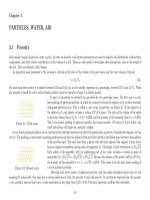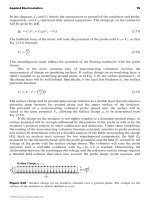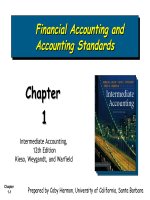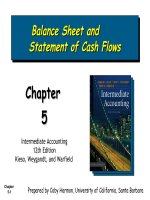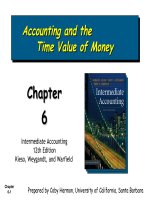- Trang chủ >>
- Khoa Học Tự Nhiên >>
- Vật lý
Hibbeler engineering mechanics (solutions manual) statics 12th edition engineering mechanics chapter 3
Bạn đang xem bản rút gọn của tài liệu. Xem và tải ngay bản đầy đủ của tài liệu tại đây (6.68 MB, 69 trang )
3 Solutions 44918
1/21/09
4:25 PM
Page 121
© 2010 Pearson Education, Inc., Upper Saddle River, NJ. All rights reserved. This material is protected under all copyright laws as they currently
exist. No portion of this material may be reproduced, in any form or by any means, without permission in writing from the publisher.
•3–1. Determine the force in each cord for equilibrium of
the 200-kg crate. Cord BC remains horizontal due to the
roller at C, and AB has a length of 1.5 m. Set y = 0.75 m.
2m
A
y
C
121
B
3 Solutions 44918
1/21/09
4:25 PM
Page 122
© 2010 Pearson Education, Inc., Upper Saddle River, NJ. All rights reserved. This material is protected under all copyright laws as they currently
exist. No portion of this material may be reproduced, in any form or by any means, without permission in writing from the publisher.
3–2. If the 1.5-m-long cord AB can withstand a maximum
force of 3500 N, determine the force in cord BC and the
distance y so that the 200-kg crate can be supported.
2m
A
y
C
122
B
3 Solutions 44918
1/21/09
4:25 PM
Page 123
© 2010 Pearson Education, Inc., Upper Saddle River, NJ. All rights reserved. This material is protected under all copyright laws as they currently
exist. No portion of this material may be reproduced, in any form or by any means, without permission in writing from the publisher.
3–3. If the mass of the girder is 3 Mg and its center of mass
is located at point G, determine the tension developed in
cables AB, BC, and BD for equilibrium.
FAB
A
45Њ
B
30Њ
D
C
G
123
3 Solutions 44918
1/21/09
4:25 PM
Page 124
© 2010 Pearson Education, Inc., Upper Saddle River, NJ. All rights reserved. This material is protected under all copyright laws as they currently
exist. No portion of this material may be reproduced, in any form or by any means, without permission in writing from the publisher.
*3–4. If cables BD and BC can withstand a maximum
tensile force of 20 kN, determine the maximum mass of the
girder that can be suspended from cable AB so that neither
cable will fail. The center of mass of the girder is located at
point G.
FAB
A
45Њ
B
30Њ
D
C
G
124
3 Solutions 44918
1/21/09
4:25 PM
Page 125
© 2010 Pearson Education, Inc., Upper Saddle River, NJ. All rights reserved. This material is protected under all copyright laws as they currently
exist. No portion of this material may be reproduced, in any form or by any means, without permission in writing from the publisher.
•3–5. The members of a truss are connected to the gusset
plate. If the forces are concurrent at point O, determine the
magnitudes of F and T for equilibrium. Take u = 30°.
A
O
8 kN
u
45Њ
D
B
T
C
5 kN
F
3–6. The gusset plate is subjected to the forces of four
members. Determine the force in member B and its proper
orientation u for equilibrium. The forces are concurrent at
point O. Take F = 12 kN.
A
O
8 kN
u
45Њ
D
B
T
C
F
125
5 kN
3 Solutions 44918
1/21/09
4:25 PM
Page 126
© 2010 Pearson Education, Inc., Upper Saddle River, NJ. All rights reserved. This material is protected under all copyright laws as they currently
exist. No portion of this material may be reproduced, in any form or by any means, without permission in writing from the publisher.
3–7. The towing pendant AB is subjected to the force of
50 kN exerted by a tugboat. Determine the force in each of
the bridles, BC and BD, if the ship is moving forward with
constant velocity.
D
C
30Њ
20Њ
B
A
50 kN
126
3 Solutions 44918
1/21/09
4:25 PM
Page 127
© 2010 Pearson Education, Inc., Upper Saddle River, NJ. All rights reserved. This material is protected under all copyright laws as they currently
exist. No portion of this material may be reproduced, in any form or by any means, without permission in writing from the publisher.
*3–8. Members AC and AB support the 300-lb crate.
Determine the tensile force developed in each member.
4 ft
3 ft
B
C
4 ft
A
127
3 Solutions 44918
1/21/09
4:25 PM
Page 128
© 2010 Pearson Education, Inc., Upper Saddle River, NJ. All rights reserved. This material is protected under all copyright laws as they currently
exist. No portion of this material may be reproduced, in any form or by any means, without permission in writing from the publisher.
•3–9. If members AC and AB can support a maximum
tension of 300 lb and 250 lb, respectively, determine the
largest weight of the crate that can be safely supported.
4 ft
3 ft
B
C
4 ft
A
128
3 Solutions 44918
1/21/09
4:25 PM
Page 129
© 2010 Pearson Education, Inc., Upper Saddle River, NJ. All rights reserved. This material is protected under all copyright laws as they currently
exist. No portion of this material may be reproduced, in any form or by any means, without permission in writing from the publisher.
3–10. The members of a truss are connected to the gusset
plate. If the forces are concurrent at point O, determine the
magnitudes of F and T for equilibrium. Take u = 90°.
y
9 kN
F
A
5 3 B
4
u
O
x
C
T
3–11. The gusset plate is subjected to the forces of three
members. Determine the tension force in member C and its
angle u for equilibrium. The forces are concurrent at point O.
Take F = 8 kN.
y
9 kN
F
A
5 3 B
4
O
u
x
C
T
129
3 Solutions 44918
1/21/09
4:25 PM
Page 130
© 2010 Pearson Education, Inc., Upper Saddle River, NJ. All rights reserved. This material is protected under all copyright laws as they currently
exist. No portion of this material may be reproduced, in any form or by any means, without permission in writing from the publisher.
*3–12. If block B weighs 200 lb and block C weighs 100 lb,
determine the required weight of block D and the angle u
for equilibrium.
u
30Њ
A
B
D
130
C
3 Solutions 44918
1/21/09
4:25 PM
Page 131
© 2010 Pearson Education, Inc., Upper Saddle River, NJ. All rights reserved. This material is protected under all copyright laws as they currently
exist. No portion of this material may be reproduced, in any form or by any means, without permission in writing from the publisher.
•3–13. If block D weighs 300 lb and block B weighs 275 lb,
determine the required weight of block C and the angle u
for equilibrium.
u
30Њ
A
B
D
131
C
3 Solutions 44918
1/21/09
4:25 PM
Page 132
© 2010 Pearson Education, Inc., Upper Saddle River, NJ. All rights reserved. This material is protected under all copyright laws as they currently
exist. No portion of this material may be reproduced, in any form or by any means, without permission in writing from the publisher.
3–14. Determine the stretch in springs AC and AB for
equilibrium of the 2-kg block. The springs are shown in
the equilibrium position.
3m
4m
C
B
kAC ϭ 20 N/m
3m
kAB ϭ 30 N/m
A
D
3–15. The unstretched length of spring AB is 3 m. If the
block is held in the equilibrium position shown, determine
the mass of the block at D.
3m
4m
C
3m
B
kAC ϭ 20 N/m
kAB ϭ 30 N/m
A
D
132
3 Solutions 44918
1/21/09
4:25 PM
Page 133
© 2010 Pearson Education, Inc., Upper Saddle River, NJ. All rights reserved. This material is protected under all copyright laws as they currently
exist. No portion of this material may be reproduced, in any form or by any means, without permission in writing from the publisher.
*3–16. Determine the tension developed in wires CA and
CB required for equilibrium of the 10-kg cylinder. Take
u = 40°.
B
A
u
30°
C
133
3 Solutions 44918
1/21/09
4:25 PM
Page 134
© 2010 Pearson Education, Inc., Upper Saddle River, NJ. All rights reserved. This material is protected under all copyright laws as they currently
exist. No portion of this material may be reproduced, in any form or by any means, without permission in writing from the publisher.
•3–17. If cable CB is subjected to a tension that is twice
that of cable CA, determine the angle u for equilibrium of
the 10-kg cylinder. Also, what are the tensions in wires CA
and CB?
B
A
u
30°
C
134
3 Solutions 44918
1/21/09
4:25 PM
Page 135
© 2010 Pearson Education, Inc., Upper Saddle River, NJ. All rights reserved. This material is protected under all copyright laws as they currently
exist. No portion of this material may be reproduced, in any form or by any means, without permission in writing from the publisher.
3–18. Determine the forces in cables AC and AB needed
to hold the 20-kg ball D in equilibrium. Take F = 300 N
and d = 1 m.
B
1.5 m
C
d
A
F
2m
D
135
3 Solutions 44918
1/21/09
4:25 PM
Page 136
© 2010 Pearson Education, Inc., Upper Saddle River, NJ. All rights reserved. This material is protected under all copyright laws as they currently
exist. No portion of this material may be reproduced, in any form or by any means, without permission in writing from the publisher.
3–19. The ball D has a mass of 20 kg. If a force of F = 100 N
is applied horizontally to the ring at A, determine the
dimension d so that the force in cable AC is zero.
B
1.5 m
C
d
A
F
2m
D
136
3 Solutions 44918
1/21/09
4:25 PM
Page 137
© 2010 Pearson Education, Inc., Upper Saddle River, NJ. All rights reserved. This material is protected under all copyright laws as they currently
exist. No portion of this material may be reproduced, in any form or by any means, without permission in writing from the publisher.
*3–20. Determine the tension developed in each wire
used to support the 50-kg chandelier.
A
30Њ
B
C
30Њ
45Њ
D
137
3 Solutions 44918
1/21/09
4:25 PM
Page 138
© 2010 Pearson Education, Inc., Upper Saddle River, NJ. All rights reserved. This material is protected under all copyright laws as they currently
exist. No portion of this material may be reproduced, in any form or by any means, without permission in writing from the publisher.
•3–21. If the tension developed in each of the four wires is
not allowed to exceed 600 N, determine the maximum mass
of the chandelier that can be supported.
A
30Њ
B
C
30Њ
45Њ
D
138
3 Solutions 44918
1/21/09
4:25 PM
Page 139
© 2010 Pearson Education, Inc., Upper Saddle River, NJ. All rights reserved. This material is protected under all copyright laws as they currently
exist. No portion of this material may be reproduced, in any form or by any means, without permission in writing from the publisher.
½3–22. A vertical force P = 10 lb is applied to the ends of
the 2-ft cord AB and spring AC. If the spring has an
unstretched length of 2 ft, determine the angle u for
equilibrium. Take k = 15 lb>ft.
2 ft
B
2 ft
u
C
k
A
P
139
3 Solutions 44918
1/21/09
4:25 PM
Page 140
© 2010 Pearson Education, Inc., Upper Saddle River, NJ. All rights reserved. This material is protected under all copyright laws as they currently
exist. No portion of this material may be reproduced, in any form or by any means, without permission in writing from the publisher.
3–23. Determine the unstretched length of spring AC if a
force P = 80 lb causes the angle u = 60° for equilibrium.
Cord AB is 2 ft long. Take k = 50 lb>ft.
2 ft
B
2 ft
u
C
k
A
P
140
3 Solutions 44918
1/21/09
4:25 PM
Page 141
© 2010 Pearson Education, Inc., Upper Saddle River, NJ. All rights reserved. This material is protected under all copyright laws as they currently
exist. No portion of this material may be reproduced, in any form or by any means, without permission in writing from the publisher.
*3–24. If the bucket weighs 50 lb, determine the tension
developed in each of the wires.
C
30Њ
B
A
5
4
D
3
30Њ
E
141
3 Solutions 44918
1/21/09
4:25 PM
Page 142
© 2010 Pearson Education, Inc., Upper Saddle River, NJ. All rights reserved. This material is protected under all copyright laws as they currently
exist. No portion of this material may be reproduced, in any form or by any means, without permission in writing from the publisher.
•3–25. Determine the maximum weight of the bucket that
the wire system can support so that no single wire develops
a tension exceeding 100 lb.
C
30Њ
B
A
5
4
D
3
30Њ
E
142
3 Solutions 44918
1/21/09
4:25 PM
Page 143
© 2010 Pearson Education, Inc., Upper Saddle River, NJ. All rights reserved. This material is protected under all copyright laws as they currently
exist. No portion of this material may be reproduced, in any form or by any means, without permission in writing from the publisher.
3–26. Determine the tensions developed in wires CD, CB,
and BA and the angle u required for equilibrium of the
30-lb cylinder E and the 60-lb cylinder F.
D
A
30Њ
C
45Њ
u
B
E
F
143
3 Solutions 44918
1/21/09
4:25 PM
Page 144
© 2010 Pearson Education, Inc., Upper Saddle River, NJ. All rights reserved. This material is protected under all copyright laws as they currently
exist. No portion of this material may be reproduced, in any form or by any means, without permission in writing from the publisher.
3–27. If cylinder E weighs 30 lb and u = 15°, determine
the weight of cylinder F.
D
A
30Њ
C
45Њ
u
B
E
F
144
3 Solutions 44918
1/21/09
4:25 PM
Page 145
© 2010 Pearson Education, Inc., Upper Saddle River, NJ. All rights reserved. This material is protected under all copyright laws as they currently
exist. No portion of this material may be reproduced, in any form or by any means, without permission in writing from the publisher.
*3–28. Two spheres A and B have an equal mass and are
electrostatically charged such that the repulsive force acting
between them has a magnitude of 20 mN and is directed
along line AB. Determine the angle u, the tension in cords
AC and BC, and the mass m of each sphere.
C
u
30Њ
B
20 mN
A
20 mN
30Њ
•3–29. The cords BCA and CD can each support a
maximum load of 100 lb. Determine the maximum weight
of the crate that can be hoisted at constant velocity and the
angle u for equilibrium. Neglect the size of the smooth
pulley at C.
D
u
C
13
12
5
B
145
A

